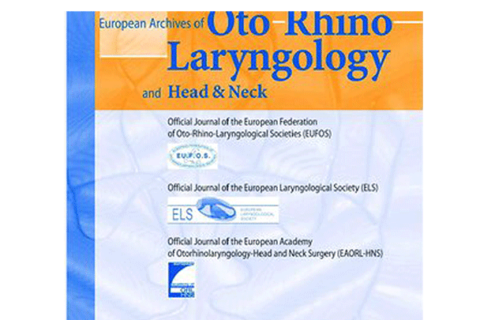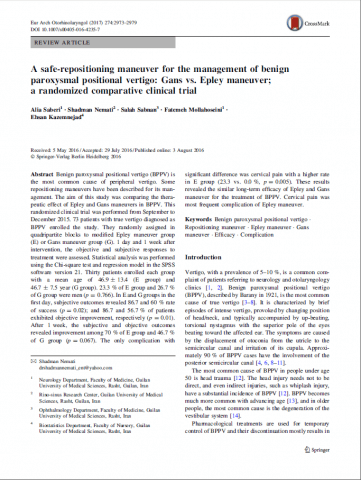
A safe-repositioning maneuver for the management of benign paroxysmal positional vertigo: Gans vs. Epley maneuver; a randomized comparative clinical trial
Published on: July 20, 2017
 Eur Arch Otorhinolaryngol (2017)
Eur Arch Otorhinolaryngol (2017)
Alia Saberi, Shadman Nemati, Salah Sabnan, Fatemeh Mollahoseini, Ehsan Kazemnejad
Abstract: Benign paroxysmal positional vertigo (BPPV) is
the most common cause of peripheral vertigo. Some
repositioning maneuvers have been described for its management.
The aim of this study was comparing the therapeutic
effect of Epley and Gans maneuvers in BPPV. This
randomized clinical trial was performed from September to
December 2015. 73 patients with true vertigo diagnosed as
BPPV enrolled the study. They randomly assigned in
quadripartite blocks to modified Epley maneuver group
(E) or Gans maneuver group (G). 1 day and 1 week after
intervention, the objective and subjective responses to
treatment were assessed. Statistical analysis was performed
using the Chi-square test and regression model in the SPSS
software version 21. Thirty patients enrolled each group
with a mean age of 46.9 ± 13.4 (E group) and
46.7 ± 7.5 year (G group). 23.3 % of E group and 26.7 %
of G group were men (p = 0.766). In E and G groups in the
first day, subjective outcomes revealed 86.7 and 60 % rate
of success (p = 0.02); and 86.7 and 56.7 % of patients
exhibited objective improvement, respectively (p = 0.01).
After 1 week, the subjective and objective outcomes
revealed improvement among 70 % of E group and 46.7 %
of G group (p = 0.067). The only complication with
significant difference was cervical pain with a higher rate
in E group (23.3 vs. 0.0 %, p = 0.005). These results
revealed the similar long-term efficacy of Epley and Gans
maneuver for the treatment of BPPV. Cervical pain was
most frequent complication of Epley maneuver.